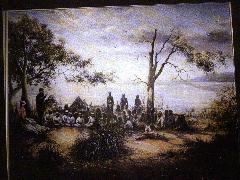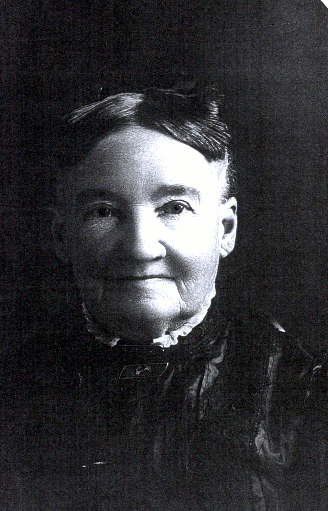Marian and Thomas Hill Goodwin, both 27, arrived in Melbourne Sept 1852 on the 'Deborah', and Marian died about 1854, after the death of their infant son. The Church of England society called the Church of England Mission to the Aborigines, decided to try to help the aborigines who were already suffering from the intrusion of whites into their lands. On 13 Sept 1854 Thomas Hill Goodwin set out to investigate possible sites for a mission, and when he returned on 14 Dec 1854 he recommended Yelta, in Victoria and opposite the conjunction of the Murray and Darling Rivers.
Early 1855 the Government of NSW (which still included the area later called Victoria) gave a square mile (640 acres or 256 hectares) grant near the Billabong called Yelta, and in the property selected by Messrs Rutherford and Crozier. On 25 May 1855 Thomas Hill Goodwin and his assistant John Bulmer (born 1828, came Aug 1852 on the 'Fanny') departed from Melbourne by bullock-dray, and were welcomed at Yelta on 3 August 1855. Supplies were stored and a vegetable garden was soon fenced and equipped with a windmill for irrigation. Handmade bricks were used to build a dwelling house, store-room and a school-room.
Yelta had been chosen as the place for a Mission because it was on an area where the aborigines met as they followed their cycle of nomadic life. Thomas learned the language of the first tribe he met, but was disconcerted that the following tribe had a different dialect. Thomas also had an extensive ministry with the surrounding settlers, and was especially welcomed at Shearing time, when the itinerant teams of shearers were pleased to have the services of the missioner.
In 1856 Victoria and New South Wales became separate states. One result was the setting up of the Swan Hill Police District, and the Cowana Bend Police Station was a mobile affair, being where-ever their tents were erected until in 1881 the Police Troopers, Customs Officers and Stock Inspector gained a base at the new township of Yelta. Yelta is later mentioned as the location of the Police station. This was before the township of Mildura was developed.
On 26 August 1861 the Court of Petty Sessions included Sgt George Pick, with Justices of the peace Hugh Jamieson of Mildura Station, Thomas Hill Goodwin of Yelta, John Crozier of Kulnine Station, and Robert Sheridan was Inspector of Sheep. The sheep disease 'scab' was a serious problem finally eradicated in the 1880s.
In October 1864 Victoria decided to open riverine Customs offices, and T D Gordon was the new appointee.
In 1858 the township of Wentworth was laid out, on the New South Wales side of the River Murray, and John Bulmer married Marian Stocks, a trained school teacher who was able to share this part of the Yelta ministry, however in 1860 she became ill and they were forced to retire to Melbourne where she died 14 Feb 1861, aged 38. John then married Caroline and they moved to Lake Tyres to start a second Mission, on the same lines as the one at Yelta.
In 1862 Mr Goodwin was ordained, and in 1864 he married Miss Letitia Goring Pennefather, and two children were born before the aborigines, the Church Missionary Society and The Rev'd Goodwin, made a mutual decision in 1868 to close Yelta. Anglicans in Wentworth were visited by Bishop Thomas in 1864, 68, 70 and 76. Bishop Linton installed The Rev'dJacob Verso as Rector of Wentworth in April 1885. The name Goodwin was chosen by one aborigine who became a well known identity in Wentworth, thus keeping alive the respect the Yelta mission earned during the 14 years it was open.
Thomas Hill Goodwin's son John Thomas Hill born 1866 at Yelta and later Colonel John Goodwin, had a term as Surveyor-General for the Commonwealth, and was the original surveyor of Canberra, where he resided after it was established. Letitia Sarah Marian born 1867 at Yelta wed J B Harrison. Olivia Caroline was born 1870, and 3 other infants each died the day they were born.
The Rev'd Goodwin held the parishes at Bacchus Marsh, Gisborne and Heathcote before being appointed Chaplain of the Melbourne General Cemetery. He learned Braille and was appointed a Life Governor of the Institute for the Blind in recognition of his work transcribing over 120 volumes.
He appears to have retired to England, as no burial record was found in the Victorian Indexes
|



 John wed in 1862 to Caroline Blay, and they decided to pioneer a mission to the Aborigines at Lake Tyers, on the Eastern Victorian coast. This was well received by the Aboriginal community and became the family's life work.
John wed in 1862 to Caroline Blay, and they decided to pioneer a mission to the Aborigines at Lake Tyers, on the Eastern Victorian coast. This was well received by the Aboriginal community and became the family's life work.